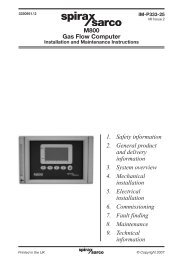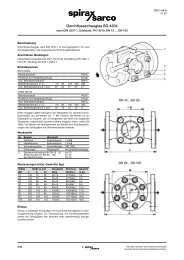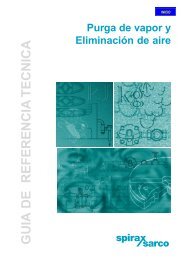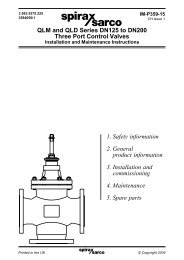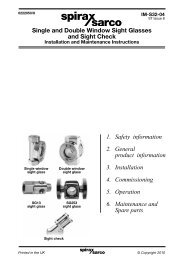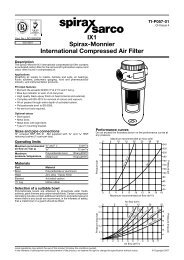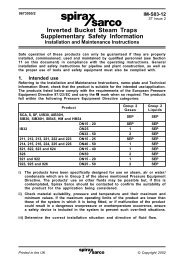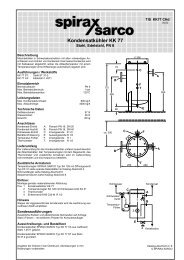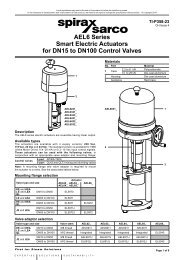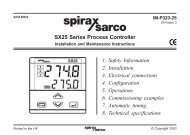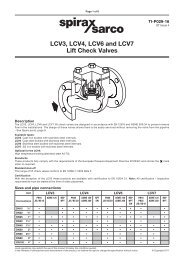2000 Hook-up Book - Spirax Sarco
2000 Hook-up Book - Spirax Sarco
2000 Hook-up Book - Spirax Sarco
You also want an ePaper? Increase the reach of your titles
YUMPU automatically turns print PDFs into web optimized ePapers that Google loves.
Increasing attention is being paid<br />
in modern plants to means of<br />
assessing steam trap performance.<br />
While it is important to<br />
know if a trap is working normally<br />
or is leaking steam into the condensate<br />
return system, most of<br />
the available methods of assessing<br />
trap operation are of much<br />
more restricted usefulness than is<br />
appreciated. To explain this, it is<br />
necessary to consider the mode<br />
of operation of each type of trap<br />
when operating and when failed,<br />
and then to see if the proposed<br />
test method can distinguish<br />
between the two conditions.<br />
Temperature Test Methods<br />
One well established “method” of<br />
checking traps is to measure temperature,<br />
either <strong>up</strong>stream or<br />
downstream. People use pyrometers,<br />
remote scanners and<br />
temperature sensitive crayons or<br />
tapes, while generations of maintenance<br />
men have thought they<br />
could assess trap performance by<br />
spitting onto the trap and watching<br />
how the spittle reacted! Certainly, if<br />
a trap has failed closed, the temperature<br />
at the trap will be lower<br />
than normal, but equally the equipment<br />
being drained will also cool<br />
down. The trap is not leaking<br />
steam since it is closed, and this<br />
failure is only a cause of problems<br />
in applications like steam main<br />
drips where the condensate not<br />
discharged at the faulty trap is carried<br />
along the steam line. More<br />
usually, the temperature on the<br />
inlet side of the trap will be at or<br />
close to the saturation temperature<br />
of steam at whatever pressure is<br />
reaching the trap. Even if the trap<br />
were blowing steam, the temperature<br />
remains much the same.<br />
The one exception is in the<br />
case of a temperature sensitive<br />
trap, especially one of the bimetal<br />
pattern. If this fails open, then the<br />
temperature at the inlet side will<br />
rise from the normal subcooled<br />
level to saturation values, and this<br />
rise may be detectable if the<br />
steam pressure is a known, constant<br />
value.<br />
Measuring temperatures on<br />
the downstream side of a trap, by<br />
whatever method, is even less<br />
likely to be useful. Let’s look first<br />
at a trap discharging through an<br />
open-ended pipe to atmosphere.<br />
The pressure at the trap outlet<br />
must be only just above atmospheric,<br />
and the temperature just<br />
above 212°F.<br />
With any condensate present<br />
with the steam at temperatures<br />
above 212°F on the inlet side, the<br />
condensate, after passing through<br />
the trap will flash down to 212°F<br />
and this temperature is the one<br />
that will be found. Any leaking<br />
steam will help evaporate a little<br />
more of the condensate without<br />
increasing the temperature.<br />
Again, the only exception which<br />
may be encountered is the low<br />
pressure steam heating system<br />
where thermostatic traps normally<br />
discharge at temperatures<br />
below 212°F into atmospheric<br />
return. A temperature of 212°F<br />
here may indicate a leaking trap.<br />
Discharge of condensate into<br />
a common return line is more<br />
usual than discharge to an open<br />
end, of course. The temperature<br />
in the return line should be the<br />
saturation temperature corresponding<br />
to the return pressure.<br />
Any increase in this temperature<br />
which may be detected will show<br />
that the return line pressure has<br />
increased. However, if trap “A”<br />
discharging into a line blows<br />
steam and the pressure in the<br />
line increases, then the pressure<br />
and temperature at traps “B” and<br />
“C” and all others on the line will<br />
also increase. Location of the<br />
faulty trap is still not achieved.<br />
Visual Determinations<br />
The release of flashing steam<br />
from condensate nullifies the<br />
effectiveness of test cocks, or<br />
three-way valves diverting a trap<br />
discharge to an open end for test<br />
purposes. It also restricts the information<br />
which can be gained from<br />
sight glasses. Consider a trap discharging<br />
to an open end some<br />
500 lbs. per hour of condensate<br />
Testing Steam Traps<br />
from a pressure of 125 psi. The<br />
steam tables show that each<br />
pound of water carries 324.7 BTU<br />
which is a144.5 BTU more than it<br />
can carry as liquid at atmospheric<br />
pressure. As the latent heat at 0<br />
psig is 970.6 BTU/hr., then<br />
144.5/970.6 lbs. of flash steam are<br />
released per pound of condensate,<br />
or 14.29%, which is some<br />
74.45 pounds per hour. The volume<br />
of steam at 0 psig is 26.8 cu.<br />
ft. per pound, so some 1,995 cu. ft.<br />
per hour of flash steam is<br />
released. The remaining water,<br />
500 - 74.45 = 425.55 lbs. has a<br />
volume of about 7.11 cu. ft. per<br />
hour. Thus, the discharge from the<br />
trap becomes 1995/1995 + 7.11 =<br />
99.65% steam and 0.35% water,<br />
by volume.<br />
It is sometimes claimed that<br />
an observer can distinguish<br />
between this “flash” steam and<br />
leakage steam by the color of the<br />
steam at the discharge point.<br />
While this may be possible when a<br />
trap is leaking steam but has no<br />
condensate load at all, so that only<br />
steam is seen at the discharge, it<br />
is obvious that the presence of any<br />
condensate will make such differentiation<br />
virtually impossible. It<br />
would be like trying to distinguish<br />
between 99.65% steam with<br />
0.35% water, and perhaps 99.8%<br />
steam with 0.20% water!<br />
Trap Discharge Sounds<br />
In a closed piping system, trap<br />
discharge sounds may be a good<br />
indicator of its operation. A simple<br />
stethoscope will be of little value,<br />
but the sound produced at ultrahigh<br />
frequencies measured by an<br />
ultrasonic instrument eliminates<br />
background noise interference.<br />
Live steam flow produces a<br />
greater and steady level of ultrasound,<br />
while flashing condensate<br />
tends to have a crackling sound<br />
and the level changes with the<br />
trap load. The problem is that the<br />
instrument requires the operator<br />
to make a judgement as to trap<br />
condition which will only be as<br />
reliable as his training and experience<br />
provide for.<br />
SYSTEM DESIGN<br />
55



